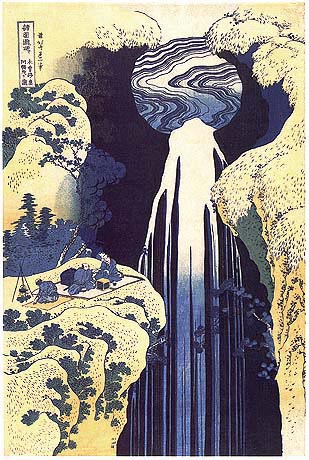| architecture |
| calligraphy |
| ceramics |
| clothing |
| comics |
| gardens |
| lacquerwork |
| literature |
| movies |
| music |
| painting |
| poetry |
| sculpture |
| tea ceremony |
| television |
| theatre |
| weaponry |
| thematic routes |
| timeline |
| the site |
context: painting > prints > subjects
Places

|
Hokusai's Amida Waterfall On The Kiso Road |
Given that the most popular printmakers in the West are Hokusai and Hiroshige, we are perhaps inclined to overestimate the significance of landscape art in Edo prints - but it was virtually non-existent for much of the period. Nonetheless, it did become very important. In the same way that I'd claim that prints of women are often a substitute for Harpers and Vogue, landscape prints remind me of travel documentaries. Design of gardens around this time were often based around virtual tours, images or more symbolic signifiers of famous sites and sights from around Japan and beyond, even mythic places on occasion. Landscape art had generally had a multitude of functions - representation was in there, but so was using legendary sites to make points, imaginary landscapes as images of Zen enlightenment, and so on. Edo prints seem to be more literal than this: the real (or apparently real) dominates, and I think the tendency to include ordinary people at work in such prints is to emphasise the down to earth reality. On the other hand, some of these artists got an awful lot of prints knocked out for people who travelled so much, so there is good reason to doubt the actual documentary accuracy of a lot of the pictures, especially those showing places far from Edo. Many of the routes depicted had been pictured time and again for centuries (though not often by artists who had actually been there), so a good artist could easily have taken a plausible crack at a distant famous site without ever going near it.
Hiroshige vs Hokusai on realism
Note that when travel became a big deal in the early 19th Century, which preceded the rise of the landscape print (and was surely a major driver in its rise), many publishers set up shop on the edge of town to sell town scenes and landscapes to tourists.
